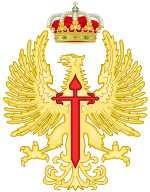Tentera Darat Sepanyol
| Tentera Darat Sepanyol | |
|---|---|
| Ejército de Tierra | |
 Lambang Tentera Darat Sepanyol | |
| Ditubuhkan pada | abad ke-15 |
| Negara | |
| Jenis | Tentera darat |
| Peranan | Peperangan darat |
| Saiz | 75,822 anggota (2018)[1] |
| Sebahagian daripada | Angkatan Tentera Sepanyol |
| Pangkalan | Istana Buenavista, Madrid |
| Maskot | Helang bermahkota dengan salib Saint James |
| Komander | |
| Pemerintah tertinggi | Raja Felipe VI |
| Ketua Turus Tentera Darat | Jeneral Ketumbukan Amador Fernando Enseñat y Berea[2] |
| Pesawat terbang | |
| Helikopter penyerang | Tiger |
| Pengawasan | MBB Bo 105 |
| Pelatih | Colibrí EC135 |
| Pengangkut | Chinook Cougar NH90 |
Tentera Darat Sepanyol (Sepanyol: Ejército de Tierra, lit. 'Land Army') adalah tentera daratan bagi Angkatan Tentera Sepanyol yang bertanggungjawab bagi operasi ketenteraan darat. Ia merupakan salah satu tentera darat aktif tertua dunia— wujud sejak dari hujung abad ke-15.
Tentera Darat Sepanyol telah wujud secara berterusan sejak pemerintahan Raja Ferdinand dan Permaisuri Isabella (akhir abad ke-15). Yang tertua dan terbesar dari tiga perkhidmatan, misinya ialah mempertahankan Semenanjung Sepanyol, Kepulauan Balear, Kepulauan Canaria, Melilla, Ceuta dan pulau-pulau serta batu-batuan Sepanyol diluar pantai utara Afrika.
Rujukan[sunting | sunting sumber]
- ^ "España Hoy 2016-2016". lamoncloa.gob.es (dalam bahasa Sepanyol). Diarkibkan daripada yang asal pada 10 May 2017. Dicapai pada 27 May 2017.
- ^ "Real Decreto 866/2021, de 5 de octubre, por el que se nombra Jefe de Estado Mayor del Ejército de Tierra al Teniente General del Cuerpo General del Ejército de Tierra don Amador Fernando Enseñat y Berea". boe.es. Dicapai pada 2021-10-06.
Bibliografi[sunting | sunting sumber]
- Instruction no. 59/2005, of 4 April 2005, from the chief of the army staff on army organisation and function regulations, published in B.O.D. NO. 80 of 26 April 2005
- Lehardy, Diego, Spanish Army in a difficult phase of its transformation, RID magazine, July 1991.
- Mogaburo López, Fernando (2017). Historia Orgánica De Las Grandes Unidades (1475–2018) (PDF). Madrid: Ministerio de Defensa – Mando de Adiestramiento y Doctrina. Dicapai pada 18 September 2020.
- Scianna, Bastian Matteo (2019). "Stuck in the past? British views on the Spanish army's effectiveness and military culture, 1946–1983". War and Society. 38 (1): 41–56. doi:10.1080/07292473.2019.1524347. S2CID 159007579. Antiquated material and limited budgets were not the only reasons for the army's low potential wartime capability after World War II. "..Spain continued to field around twenty divisions, whereas the defence industry and available national resources could only sustain six operational divisions. A regular Spanish infantry division could muster full strength with modern infantry weapons, while other ‘teeth’ units — like the artillery and engineers — were reduced to one-third of their ideal levels. The supporting ‘tail’ was so underdeveloped that divisions were statically bound to their home depot and could only defend their military district after six months mobilisation.." [The paper] draws on British and German sources to demonstrate how Spanish military culture prevented an augmented effectiveness and organisational change.
Pautan luar dan bacaan lanjut[sunting | sunting sumber]
| Wikimedia Commons mempunyai media berkaitan Tentera Darat Sepanyol |
- Home page of the Spanish Land Army (dalam bahasa Inggeris)
- Recruitment page (dalam bahasa Sepanyol)
- The Spanish Military Forum
